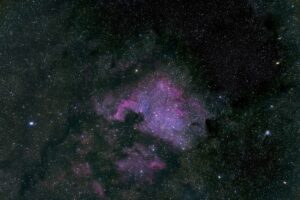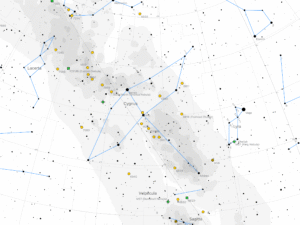An emission nebula
North America Nebula
The North America Nebula, also known as NGC 7000, is a vast emission nebula located in the constellation Cygnus, about 2,590 light-years from Earth. Named for its striking resemblance to the North American continent, the nebula displays distinct shapes resembling the Gulf of Mexico, Florida, and even the eastern coastlines of the United States and Mexico. The nebula spans about 100 light-years across and is part of a much larger gas complex that also includes the Pelican Nebula, an adjoining structure that appears to “fly” alongside it. Both nebulae are situated within the Orion Arm of the Milky Way galaxy, which makes them particularly prominent in the northern hemisphere’s summer skies.
The North America Nebula glows with the characteristic red and pink hues of ionized hydrogen gas, which is set aglow by nearby young, hot stars. Although these stars are largely obscured by dense regions of interstellar dust, the light they emit excites the surrounding hydrogen atoms, causing them to emit this iconic pinkish-red light. The “Gulf of Mexico” region within the nebula is particularly dark because it is an area of dense, cold dust that blocks light from passing through, forming a prominent, dark silhouette. This combination of bright emission regions and dark absorption regions gives the nebula its highly textured, almost photographic quality when viewed through telescopes and in astrophotography.

Observing the North America Nebula can be challenging without specialized equipment, as it appears faintly to the naked eye under very dark skies and is typically best viewed through binoculars or wide-field telescopes. Modern imaging techniques using filters can bring out incredible details, revealing the intricate structures within the nebula’s gas and dust. The nebula’s captivating appearance and vibrant colors make it a popular target for amateur and professional astronomers alike, and it remains one of the most photographed and studied regions of star formation in our galaxy.
Nikon D750 at 240 mm on Star Adventurer GTi
Wisconsin, United States
